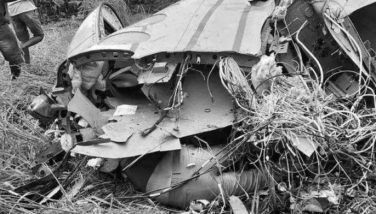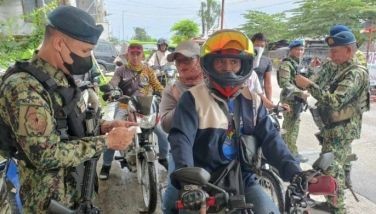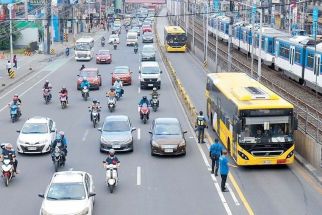Arroyo inaugurates Benguet viaduct
December 29, 2001 | 12:00am
BADIWAN, Tuba, Benguet — President Arroyo "rode through" the engineering wonder that is the Badiwan viaduct along the Marcos Highway here the other day, some nine days after it was originally scheduled to be inaugurated.
The viaduct — which cost P616.15 million and took four years and three months to build, starting on Sept. 27, 1997, due to labor strikes and pickets — was designed to solve, once and for all, the rock slides that had blocked the thoroughfare during heavy downpours.
The viaduct has a 519-meter long bridge and a 327-meter rockshed. The bridge is located on a "compound curve" whose abutments on 12 concrete hammer-shaped piers are supported on caissons about 16 to 26 meters deep. Some abutments are supported by a "spread footing."
The bridge super-structure, on the other hand, consists of 13 spans of "cast-in-place post-tensioned box girder (which is) continuous over 13 spans."
The rockshed — whose roof was designed for falling rocks to slide into the ravine — has a center section through which the "major water flow from the spillway of the reservoir on top of the mountain" will pass.
The rockshed’s roof structure can withstand the crushing weight of falling rocks from the shoulder of Mt. Sto. Tomas.
The Badiwan stretch, with a total length of 47.10 kilometers, is composed of four road segments: the 2.1-km Rosario Diversion Road, the 15.5-km. Pugo-Tuba section between La Union and Benguet, the 19.6-km. Rosario-Pugo section in La Union, and the 10.1-km. Tuba-Baguio section.
The repair work on the Badiwan stretch was completed ahead of the viaduct which overlooks the western border of Baguio City.
Accompanying the President at the viaduct’s inauguration were Public Works and Highways Secretary Simeon Datumanong, Tuba Mayor Jose Baluda, Baguio City Mayor Bernardo Vergara and Rep. Mauricio Domogan, and Japanese Counsellor Takashi Hoshiyama.
The repair of Marcos Highway was funded with a loan from the Japan Bank for International Cooperation.
The Japanese government extended the loan after the deadly earthquake in 1990 damaged Baguio City’s access roads.
By providing a fast and safe land route between Southern and Northern Luzon, the newly rehabilitated road will "help bring investment and tourism northward, thus contributing to the socio-economic development of Benguet," the Japanese Embassy said in a statement.
The viaduct — which cost P616.15 million and took four years and three months to build, starting on Sept. 27, 1997, due to labor strikes and pickets — was designed to solve, once and for all, the rock slides that had blocked the thoroughfare during heavy downpours.
The viaduct has a 519-meter long bridge and a 327-meter rockshed. The bridge is located on a "compound curve" whose abutments on 12 concrete hammer-shaped piers are supported on caissons about 16 to 26 meters deep. Some abutments are supported by a "spread footing."
The bridge super-structure, on the other hand, consists of 13 spans of "cast-in-place post-tensioned box girder (which is) continuous over 13 spans."
The rockshed — whose roof was designed for falling rocks to slide into the ravine — has a center section through which the "major water flow from the spillway of the reservoir on top of the mountain" will pass.
The rockshed’s roof structure can withstand the crushing weight of falling rocks from the shoulder of Mt. Sto. Tomas.
The Badiwan stretch, with a total length of 47.10 kilometers, is composed of four road segments: the 2.1-km Rosario Diversion Road, the 15.5-km. Pugo-Tuba section between La Union and Benguet, the 19.6-km. Rosario-Pugo section in La Union, and the 10.1-km. Tuba-Baguio section.
The repair work on the Badiwan stretch was completed ahead of the viaduct which overlooks the western border of Baguio City.
Accompanying the President at the viaduct’s inauguration were Public Works and Highways Secretary Simeon Datumanong, Tuba Mayor Jose Baluda, Baguio City Mayor Bernardo Vergara and Rep. Mauricio Domogan, and Japanese Counsellor Takashi Hoshiyama.
The repair of Marcos Highway was funded with a loan from the Japan Bank for International Cooperation.
The Japanese government extended the loan after the deadly earthquake in 1990 damaged Baguio City’s access roads.
By providing a fast and safe land route between Southern and Northern Luzon, the newly rehabilitated road will "help bring investment and tourism northward, thus contributing to the socio-economic development of Benguet," the Japanese Embassy said in a statement.
BrandSpace Articles
<
>
- Latest
- Trending
Trending
Latest
Trending
Latest
Recommended


































